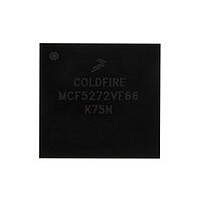MCF5272VF66 Freescale, MCF5272VF66 Datasheet - Page 289

MCF5272VF66
Manufacturer Part Number
MCF5272VF66
Description
Manufacturer
Freescale
Datasheet
1.MCF5272VF66.pdf
(544 pages)
Specifications of MCF5272VF66
Family Name
MCF5xxx
Device Core
ColdFire
Device Core Size
32b
Frequency (max)
66MHz
Instruction Set Architecture
RISC
Supply Voltage 1 (typ)
3.3V
Operating Temp Range
0C to 70C
Operating Temperature Classification
Commercial
Mounting
Surface Mount
Pin Count
196
Package Type
MA-BGA
Lead Free Status / RoHS Status
Not Compliant
Available stocks
Company
Part Number
Manufacturer
Quantity
Price
Company:
Part Number:
MCF5272VF66
Manufacturer:
HYNIX
Quantity:
19
Company:
Part Number:
MCF5272VF66
Manufacturer:
FREESCAL
Quantity:
885
Company:
Part Number:
MCF5272VF66
Manufacturer:
Freescale Semiconductor
Quantity:
10 000
Part Number:
MCF5272VF66
Manufacturer:
FREESCALE
Quantity:
20 000
Company:
Part Number:
MCF5272VF66J
Manufacturer:
Freescale
Quantity:
256
Company:
Part Number:
MCF5272VF66J
Manufacturer:
Freescale Semiconductor
Quantity:
10 000
Company:
Part Number:
MCF5272VF66R2
Manufacturer:
Freescale Semiconductor
Quantity:
10 000
Company:
Part Number:
MCF5272VF66R2J
Manufacturer:
Freescale Semiconductor
Quantity:
10 000
- Current page: 289 of 544
- Download datasheet (7Mb)
12.4
This section describes architecture and applications.
12.4.1
At power-up, the USB module should be initialized within 20 ms if the USB port is connected. This time
corresponds to the 10 ms reset signaling and 10 ms reset recovery time when a device is detected. The
following steps are necessary to initialize the USB module for operation:
12.4.2
Although the USB module handles the SET_CONFIGURATION and SET_INTERFACE requests, the
user is still required to perform some initialization when the configuration or alternate settings change. A
configuration or alternate setting change is signaled by the DEV_CFG interrupt. The following steps are
required to service the DEV_CFG interrupt.
Freescale Semiconductor
1. Clear EP0CTL[CFG_RAM_VAL,USB_EN].
2. Load the configuration RAM with the descriptors from external ROM. The starting configuration
3. Select the internal or external USB transceiver in EPC0TL.
4. Write IEP0CFG and OEP0CFG to initialize the EP0 IN and OUT FIFOs.
5. Initialize the EP0 interrupt vectors.
6. Clear all interrupt bits in EP0ISR.
7. Enable the desired EP0 interrupt sources in EP0IMR.
8. Set EP0CTL[USB_EN, CFG_RAM_VALID].
1. Read EPSR0 and ASR to determine the current configuration and alternate settings.
2. Read the endpoint descriptors for the current configuration and alternate settings to determine the
3. Write EPnCFG for all active endpoints to initialize the FIFOs.
4. Initialize the interrupt vectors for the active endpoints.
5. Clear all interrupt bits in the EPnISR registers for all active endpoints.
6. Enable the desired interrupt sources in the EPnIMR registers.
7. Clear the DEV_CFG interrupt bit to allow the USB module to access the FIFOs.
RAM address is MBAR + 0x1400.
endpoint type and maximum packet size for all of the active endpoints.
Software Architecture and Application Notes
USB Module Initialization
USB Configuration and Interface Changes
MCF5272 ColdFire
®
Integrated Microprocessor User’s Manual, Rev. 3
Universal Serial Bus (USB)
12-31
Related parts for MCF5272VF66
Image
Part Number
Description
Manufacturer
Datasheet
Request
R
Part Number:
Description:
Mcf5272 Coldfire Integrated Microprocessor User
Manufacturer:
Freescale Semiconductor, Inc
Datasheet:

Part Number:
Description:
MCF5272 Interrupt Service Routine for the Physical Layer Interface Controller
Manufacturer:
Freescale Semiconductor / Motorola
Datasheet:

Part Number:
Description:
TOWER ELEVATOR BOARDS HARDWARE
Manufacturer:
Freescale Semiconductor
Datasheet:

Part Number:
Description:
TOWER SERIAL I/O HARDWARE
Manufacturer:
Freescale Semiconductor
Datasheet:

Part Number:
Description:
LCD MODULE FOR TWR SYSTEM
Manufacturer:
Freescale Semiconductor
Datasheet:

Part Number:
Description:
DAUGHTER LCD WVGA I.MX51
Manufacturer:
Freescale Semiconductor
Datasheet:

Part Number:
Description:
TOWER SYSTEM BOARD MPC5125
Manufacturer:
Freescale Semiconductor
Datasheet:

Part Number:
Description:
KIT EVALUATION I.MX51
Manufacturer:
Freescale Semiconductor
Datasheet:

Part Number:
Description:
KIT DEVELOPMENT WINCE IMX25
Manufacturer:
Freescale Semiconductor
Datasheet:

Part Number:
Description:
TOWER SYSTEM KIT MPC5125
Manufacturer:
Freescale Semiconductor
Datasheet:

Part Number:
Description:
TOWER SYSTEM BOARD K40X256
Manufacturer:
Freescale Semiconductor
Datasheet:

Part Number:
Description:
TOWER SYSTEM KIT K40X256
Manufacturer:
Freescale Semiconductor
Datasheet:

Part Number:
Description:
Microcontrollers (MCU) MX28 PLATFORM DEV KIT
Manufacturer:
Freescale Semiconductor
Datasheet:

Part Number:
Description:
MCU, MPU & DSP Development Tools IAR KickStart Kit for Kinetis K60
Manufacturer:
Freescale Semiconductor
Datasheet:

Part Number:
Description:
24BIT HDMI MX535/08
Manufacturer:
Freescale Semiconductor
Datasheet:











